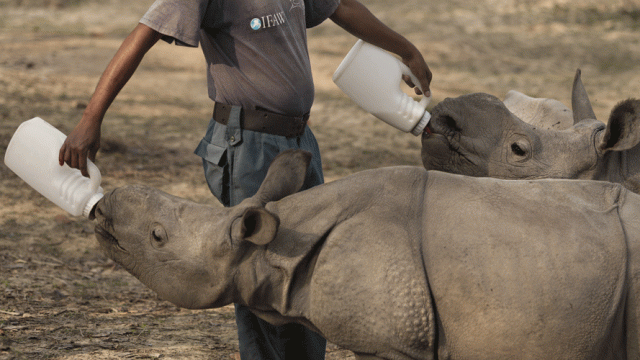In the Kaziranga National Park in Assam, orphaned rhinos are suffering from constipation. A 36-year-old veterinarian spends his days examining these ‘little’ animals, often flitting between his two main worries—their poop and their milk.
On the dusty lands of Jaisalmer, Rajasthan, the first woman forest ranger of the Desert National Park has an unpredictable daily to-do list—from putting her child to sleep, protecting the Indian Bustard to fighting literal fires with the local villagers.
Meanwhile, Northeastern tribes near the Pakke Tiger Reserve have their hands tied up with handicraft. They make artificial hornbill beaks made of fiberglass in exchange for real beaks from locals in an attempt to conserve the majestic bird whose beak reputation precedes it.
In the deluge of headlines that hit numbers on the head, and texts that rarely rise above startling statistics, who tell stories such as these? Through the ongoing Ranger Ranger project, Delhi-based journalist Sonali Prasad does.

Ranger Ranger is a series of reported articles that take you behind the curtains of wildlife in India. The project aims to tell (and in many cases, show) stories of people working in the background—forest guards, rangers, tribals, veteranians and village volunteers, to name a few. In short, of those men and women working tirelessly to ensure that the tiger is alive and protected and the baby rhino has regular bowels.
It all began when Prasad came across a report that highlighted that India had the highest rate of forest ranger mortality in the world. This was back in 2015. “In the conversation about conservation and animals, no one talks about the people protecting them,” says the reporter.
At the time, Prasad was an environmental reporter in New York for Columbia University. In 2016, she won the Pulitzer Travelling Fellowship, and came to India to begin this project. “I started this in order to humanise concepts such as climate change, biodiversity and extinction. If I represented facts on climate change and biodiversity, it wouldn’t connect with readers,” she shares.
This is why in the past two years, Prasad has visited six national parks in India, from Haratput, Intangki, Sariska, to Pakke, Desert National Park and Kaziranga, spending extensive periods of time among both the people and creatures alike. She has written about the lesser-known creatures in the parks, such as the orange-spotted Tokay gecko lizard in the story ‘A Legion For The Lizard’. In ‘Resurrecting Paper Tigers’, she writes about the almost phoenix-like rebirth of tigers in Sariska. These stories, are up on the Mukha website, and are a collaboration between Prasad and other photographers, illustrators and designers.
The Thick of the Problem
When reporting about the people, Prasad didn’t want to idealise them. “They come with flaws. There is a lack of training, and a treatment of their work as a government job,” she says.

However, the problems they face are very real and all too often neglected, sometimes because of a communication gap with their seniors. In Desert National park, Sukhpali, the first female guard to be employed faces basic problems of water, electricity and security. At Sariska National Park, the forest guards didn’t have sweaters and were too cold to the bones. At most national parks, there is also an underlying strained relationship between the people of the forest and villagers.
Prasad, after each visit, sends the written articles back to the chief conservator or the forest head, along with observations made. There is an action taken to correct the problems, although slow. For instance, a few months after the Sariska visit, she received a photograph of the rangers wearing their new sweaters.
The upcoming projects will involve a visit to Central India to cover fish species in Madhya Pradesh and to Goa to talk about the guards who protect mushrooms from being overharvested. She is also going to the Maldives to write about Manta Ray conservation.
Going Offline

On the event of World Tiger Day (July 29) and World Ranger Day (July 31), Ranger Ranger has arranged an offline exhibit at Jor Bagh metro station. This installation has been put in association with WWF, and will be on display till August 10.
An information panel with photographs and excerpts from four main stories has been set up. Commuters who are interested in reading furthermore can simply scan the QR code and be redirected to the main article online.
This is Ranger Ranger’s first such event, and in the future too, Prasad hopes to spread the stories as far as possible in whatever medium possible. “I only hope that there is some change, and some kind of impact. That is, after all, what journalists work for.”




